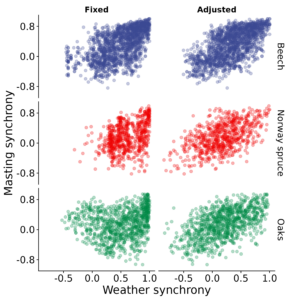We are thrilled to announce the publication of our latest paper in Ecology Letters, which was primarily developed in the Forest Biology Center.
Masting is a fascinating natural phenomenon characterized by stunning, regional synchrony, with the Moran effect being responsible for reproduction in response to synchronized weather variations. However, species differ significantly in the degree of synchrony they exhibit, even when exposed to similar weather conditions. Why is this so?
Our research reveals that the spatiotemporal conservation of weather cues plays a critical role in driving this interspecific variation. If populations respond to a single cue simultaneously, they achieve synchrony. Conversely, if populations vary in the timing of the weather driver for seed production, synchrony cannot be attained.
Once we account for these phenological differences, weather becomes a reliable predictor of the scale of regional synchrony in both “highly” and “poorly” synchronized species. Take a look at how nicely the relationship between masting and weather synchrony aligns in oaks once we adjust for phenology!


